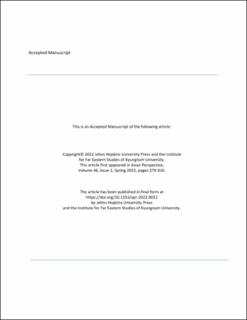| dc.contributor.author | Heggelund, Gørild | |
| dc.contributor.author | Rosendal, G. Kristin | |
| dc.contributor.author | Andresen, Steinar E | |
| dc.contributor.author | Steindal, Eirik Hovland | |
| dc.contributor.author | Lin, Yan | |
| dc.contributor.author | Wang, Shuxiao | |
| dc.contributor.author | Zhang, Haibin | |
| dc.date.accessioned | 2022-09-09T12:49:03Z | |
| dc.date.available | 2022-09-09T12:49:03Z | |
| dc.date.created | 2022-03-17T14:11:08Z | |
| dc.date.issued | 2022 | |
| dc.identifier.citation | Asian Perspective. 2022, 46 (2), 279-310. | en_US |
| dc.identifier.issn | 0258-9184 | |
| dc.identifier.uri | https://hdl.handle.net/11250/3016923 | |
| dc.description.abstract | China has undertaken a major shift in its position on mercury as an environmental problem over the last decade and a half. It ratified the Minamata Convention (MC) in 2016 and by doing so has committed to implement the treaty objectives. This article asks: How do we explain China’s will and ability to implement its MC obligations? There is little systematic knowledge about the main factors underlying implementation of international mercury objectives in China, hence this article contributes new research on this important topic. We examine the implementation process, focusing on the coal sector and differentiate between indirect effects from other policies and direct efforts to implement obligations. We find that China has moved toward stricter regulation of mercury emissions and direct implementation of the Minamata Convention in the coal sector. However, our study shows that local implementation capacity needs improvement. | en_US |
| dc.language.iso | eng | en_US |
| dc.publisher | Johns Hopkins University Press and the Institute for Far Eastern Studies of Kyungnam University | en_US |
| dc.title | Implementing the Minamata Convention on Mercury: Will China Deliver? | en_US |
| dc.type | Peer reviewed | en_US |
| dc.type | Journal article | en_US |
| dc.description.version | acceptedVersion | en_US |
| dc.rights.holder | Copyright© 2022 Johns Hopkins University Press and the Institute for Far Eastern Studies of Kyungnam University. | en_US |
| dc.source.pagenumber | 279-310 | en_US |
| dc.source.volume | 46 | en_US |
| dc.source.journal | Asian Perspective | en_US |
| dc.source.issue | 2 | en_US |
| dc.identifier.doi | 10.1353/apr.2022.0012 | |
| dc.identifier.cristin | 2010527 | |
| dc.relation.project | Norges forskningsråd: 268443 | en_US |
| dc.relation.project | Fridtjof Nansens institutt: 436 | en_US |
| cristin.ispublished | true | |
| cristin.fulltext | postprint | |
| cristin.qualitycode | 1 | |
